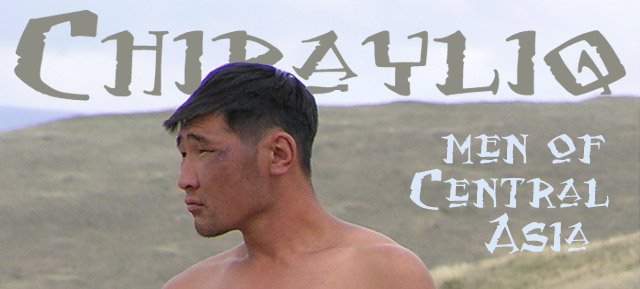It is a popular sport all over Central Asia, and has been adopted as "polo" in some other parts of the world.
One of the differences between the Central Asian and the Western versions of the game is that in the West, you use a ball and a club, while in the East, you use a dead goat or sheep and your bare hands. Certainly this shows that Central Asian men are just tougher.
(Those who think using a dead goat or sheep is somehow terrible might want to consider whose hide your average leather football is made of. At least the goats and sheep have not been manufactured in sweatshops using underpaid child labour.)
Here, I'll focus on photos of Ulak-Tartysh as it is played in Kyrgyzstan. (I was, of course, researching for this post when I came across the guys in the post below ...)
Christopher Herwig has photographed a game of Ulak-Tartysh at a hippodrome outside Bishkek. Here is the whole set and his description at Flickr. Highlights (click for full size):
The players are wearing hockey helmets, or no helmets at all. The leather variations look like Russian/Soviet tank soldier helmets, but are actually old-style leather hockey helmets (our dad used to have helmets like that at some point).
Some particularly cute guys grabbing the goat, photographed by Jonathan Wilson at Trekearth.com (click for full size):

Ronald de Hommel has a quite interesting website with photoreportages from many parts of the world. While in Kyrgyzstan, he also covered Ulak-Tartysh:


The doggies also participate.

Fascinating. Regarding the goat: the goat is already dead, so PETA needn't worry. Far more cruelty is inflicted on chickens throughout their lives at those industrial chicken farms. Don't nomadic people emphasize a quick slaughter of animals to avoid torture?
ReplyDeleteP.S. How does the goat become dead? Do they choose one that has died of disease or otherwise met its natural end? Do they just kill it?
First of all, I support PETA, and I don't think the organisation as a whole would bother about this practise. I was thinking more about the type of people who condemn something (playing ulak-tartysh with a goat carcass) but, lacking knowledge and awareness, forget about types of cruelty towards animals that are not as apparent (such as factory farming). And no, I don't think the organisation PETA lacks knowledge and awareness. :o) They don't seem to have any documents on this sport on their website.
ReplyDeleteAnyway, as you say, the animal is already dead while this happens, so it doesn't hurt the animal.
I would assume the animal has been slaughtered especially for the game. In the Wikipedia article linked to at the top of the post, it says: "The calf in a Buzkashi game is normally beheaded and disemboweled and has its limbs cut off at the knees. It is then soaked in cold water for 24 hours before play to toughen it. Occasionally sand is packed into the carcass to give it extra weight."
I assume it is later fed to dogs, not humans (at least the dogs in the bottom picture seem very excited), but I don't know for sure.
Interesting. It sounds like many people in the West might find the practice disgusting. To be honest, even I would find it unpleasant. Where does that yucky perception come from? Everybody sees the outcome of animal slaughter in shops, restaurants and in their fridges every day. What's your take on that?
ReplyDeleteMy theory is that it has to do with the detachment many western people have from the production of their food and other things. People buy food and things in shops, but many of them know little about where it comes from and how it is made.
ReplyDeleteThat can then have the effect that people become more sensitive towards death and dead bodies. As you might not be fully aware of the whole production chain from a calf grazing on the meadow to a leather jacket or a steak, it might confuse you and perhaps disgust you when you are confronted with some stage from in between.
Whereas many of these guys playing Ulak-Tartysh are probably herdsmen and know every stage of raising animals for meat quite well. They don't see any problem with handling a goat carcass, because they do that all the time anyway (though it's perhaps not always as much fun as playing with it like this ...).
Nice explanation. You know, people from developed countries tend to have an extreme reaction to that kind of images. Some say it's a sign of a backward society. Others say it's a society that lives in harmony with the nature. Both have a point, don't they? But then what's the truth here?
ReplyDeleteThere is no objective truth. :o)
ReplyDeleteI suppose the reactions of people from so-called developed countries (I prefer the Swedish term industrial countries, even though it's not entirely correct either) reflect these people's own ideals. If they have a romantic view of a pastoralist-nomadic society, they would seek positive explanations even if they feel that something is slightly unpleasant. In that case, the unpleasant emotion is seen as a weakness to be overcome. Another reaction would be to confirm one's own "superior" identity by condemning the "other". The personal disgust is turned into a moral judgment.
ReplyDeleteI guess the same principle applies to educated circles in the "undeveloped" countries, too (because no country exists in a vacuum). They might be caught between two viewpoints: Either praising their own people for being "authentic", or lamenting their backwardness and trying to "civilize" them. One might call this self-exoticism.